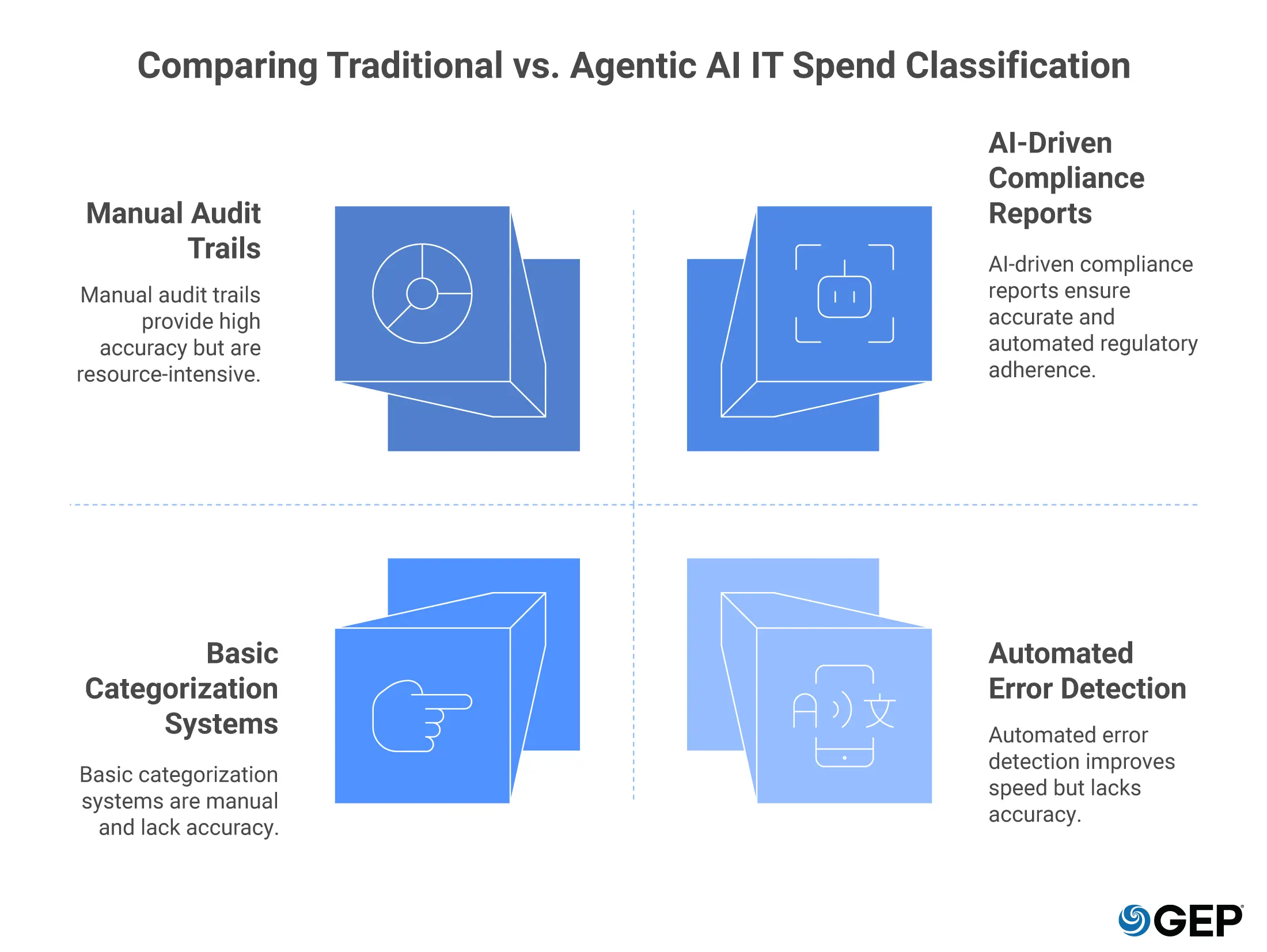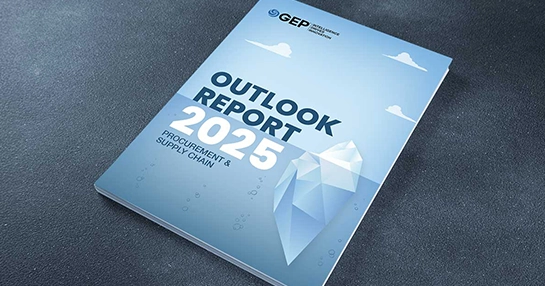
Why Smart Organizations Choose Agentic AI for IT Spend Classification
- Manual IT spend classification wastes time and leads to costly data inconsistencies.
- Agentic AI achieves more than 95 percent classification accuracy while processing thousands of transactions simultaneously.
- AI transforms procurement from reactive transaction processing to strategic spend optimization and predictive budgeting.
October 08, 2025 | Technology 6 minutes read
Businesses globally are grappling with a significant challenge in managing their technology investments. According to Gartner, worldwide IT spending is expected to reach $5.74 trillion in 2025. What this means is traditional methods of classifying and categorizing IT services won’t be sufficient.
Agentic AI provides a transformative solution. It addresses the fundamental limitations of traditional classification approaches while providing organizations with the accuracy, speed, and insights required for effective IT spend management.
Does your spend classification support custom hierarchies?
Transform your procurement with AI-powered, taxonomy-agnostic spend classification from GEP
The Core Issue: Why Traditional IT Spend Classification Falls Short
Current classification methods sometimes cannot tackle the complexity of modern IT spending. But enterprises continue to use manual processes and basic categorization systems, both of which struggle with diverse technology purchases. These approaches create multiple bottlenecks, including stalling strategic decision-making.
Slow and Erroneous Manual Classification
Manual classification consumes time and resources while producing inconsistent results. Procurement teams spend weeks reviewing invoices, attempting to match vendor names with appropriate categories, and making subjective decisions about new or unfamiliar services. This also brings in variability that compounds over time.
Multiple employees may at times classify identical services differently, creating data inconsistencies that persist across reporting periods. For example, Microsoft Azure could appear as "cloud services" in one report and "software licenses" in another, rendering the resulting data unfit for analysis.
Processing speed limitations create additional problems during critical business periods. Furthermore, classification accuracy suffers when teams handle high transaction volumes.
Error rates increase as processors become overwhelmed, leading to misclassified expenses that affect financial reporting and vendor management. These errors often skip detection until quarterly reviews or audit processes.
Hidden Costs and Budgeting Inconsistencies
Inconsistent classification creates gaps in visibility, obscuring true IT spending patterns. Services may appear in different categories across reporting periods, making trend analysis and budget forecasting nearly impossible. A cloud storage solution might be classified as "utilities" in one quarter and "infrastructure" in another.
Budget planning becomes unreliable when historical data lacks consistency. Finance teams can't identify accurate spending patterns or predict future requirements when underlying classifications change arbitrarily.
Low Spend Transparency and Compliance Issues
Regulatory requirements demand precise tracking and reporting of technology expenditures, particularly in healthcare, finance, and government sectors. Manual classification systems can't provide detailed audit trails and consistent categorization that the regulations ask.
Risk management becomes ineffective without accurate spend visibility. Organizations can't identify vendor concentration risks, monitor contract compliance, or track spending against established policies when classification data is unreliable.
Organizations must therefore dedicate significant resources to reconstruct spending histories and provide explanations for classification decisions during compliance reviews.
Looking for Strategies to Align Category Management With Broader Business Objectives?
Get this whitepaper and explore how AI can position category managers as business enablers
Comparing Agentic AI with Traditional IT Spend Classification
Traditional systems quite often operate reactively, processing transactions after they occur without learning from patterns or adapting to changes. There's a constant need for human intervention, but results produced may still vary based on individual interpretation.
Agentic AI transforms this approach by analyzing spending patterns proactively, predicting appropriate classifications, and continuously improving accuracy through machine learning. The technology can handle thousands of transactions at once while keeping the same rules for classifying all purchases.
Learning capabilities distinguish AI systems from rule-based alternatives. Traditional classification relies on static rules that require manual updates as business needs change. Agentic AI adapts automatically to new spending patterns, vendor relationships, and service types without requiring programming changes.
Scalability differences become apparent as transaction volumes grow.
Overcoming Hurdles in Implementation
Implementing agentic AI for IT spend classification requires addressing both technical and organizational challenges. Businesses must put effort in change management to address concerns about AI implementation, bring implementation costs under control, and resolve data integration issues to realize the full potential of automated classification. Teams need to understand that agentic AI enhances rather than replaces human expertise.
Initial Technology Investment Challenges
Initial costs in AI implementation could seem high, particularly for businesses with limited technology budgets. But comprehensive cost-benefit analysis typically demonstrates significant long-term value through reduced labor costs as well as better accuracy and spending decisions.
Integration expenses often exceed initial software licensing costs. Organizations must be able to connect AI systems with their legacy systems, including accounting systems and procurement tools. This integration requires technical expertise and may necessitate dedicated consultant support during the implementation phase, but this also ensures sustainable long-term benefits.
Return on investment is typically realized within the first year of implementation.
Complexities in Data Integration
Most businesses now maintain spend data across systems in several formats, naming conventions, and data structures. Agentic AI needs access to complete, standardized information in order to provide accurate classifications. And achieving this integration presents technical and organizational challenges.
Data quality issues complicate AI implementation. Businesses must invest in data cleansing and standardization before AI systems can deliver optimal results.
Real-time integration as well requires strong technical infrastructure, including API development, database modifications, or middleware implementation, for seamless data flow between systems.
How Agentic AI is Transforming IT Spend Classification
Agentic AI represents a big shift from reactive to proactive spend management. Instead of classifying expenses after they occur, intelligent systems analyze patterns, predict categories, and provide real-time insights that enable strategic decision-making about technology investments.
AI for Automated Spend Categorization
Advanced agentic AI systems can process thousands of transactions in one go while achieving classification with more than 95% accuracy rates. These systems analyze historical data, recognize vendor patterns, and understand transaction contexts to deliver intelligent categorization decisions.
Complex scenarios that challenge traditional rule-based systems are handled effectively by AI technology. When vendors provide multiple services under single invoices, agentic AI parses details and allocates expenses to appropriate categories automatically. This granular analysis provides unprecedented visibility into spending patterns and vendor relationships.
Pattern recognition extends beyond basic categorization to spot anomalies, flag unusual transactions, and suggest optimizations.
AI-Enhanced Compliance and Risk Management
Regulatory compliance can be managed better with AI-powered classification systems. These platforms can maintain detailed audit trails automatically, apply consistent categorization rules, and generate compliance reports without any manual intervention. Businesses can thereby demonstrate spend transparency to regulators and auditors efficiently.
Risk identification improves significantly when AI systems analyze spending patterns across all vendors and categories. The technology identifies vendor concentration risks, detects unusual spending patterns, and monitors contract compliance automatically. These insights enable proactive risk management instead of a reactive approach to problem resolution.
Policy enforcement becomes automated through intelligent classification systems. Further, contract management integration enables AI systems to link spending classifications with contract terms and conditions. This connection enables automatic compliance monitoring, identifies optimization opportunities, and ensures businesses get contracted benefits and discounts.
Predictive Analytics for Smarter Budgeting Decisions
AI transforms historical spend data into predictions that can change the way budget planning processes. Analysis of classification patterns, seasonal variations, and business growth indicators, enables these systems to forecast future spend needs with remarkable accuracy compared to traditional estimation methods.
Predictive capabilities can identify emerging spend categories before they become significant budget items. As businesses onboard newer technologies, AI systems can spot these trends and alert finance teams in advance to accordingly adjust the budget allocations.
Furthermore, AI systems can simulate diverse business scenarios and predict their impact on IT spend across categories. This capability enables sophisticated budget planning and comprehensive risk assessment.
Budget variance analysis improves when AI systems provide real-time classification and spending insights, enabling enterprises to easily identify deviations.
AI-Driven Vendor Benchmarking and Procurement Optimization
Intelligent classification systems enable comprehensive vendor analysis by accurately categorizing spending across suppliers and service types. Organizations can compare vendor performance, identify consolidation opportunities, and negotiate better contracts based on complete spending visibility.
Market benchmarking becomes routine when AI systems compare organizational spending patterns with industry standards and peer organizations. These insights enable procurement teams to identify cost optimization opportunities and ensure competitive pricing across all technology categories.
Discover More: Spend Management Software
Conclusion
The adoption of agentic AI in IT spend marks a strategic transformation in corporate financial transparency and procurement decision-making processes. As technology environments become more complex, automated classification is essential for staying ahead of the competition.
AI integration with business intelligence platforms will create unified views that connect technology spending with business outcomes. By combining AI capabilities with human expertise, enterprises can develop procurement functions that generate business value beyond transaction processing.
The human element however remains essential for interpreting results and making strategic decisions. Success requires organizations to blend AI capabilities with human wisdom, creating procurement operations that are both operationally efficient and strategically valuable for long-term business success.




